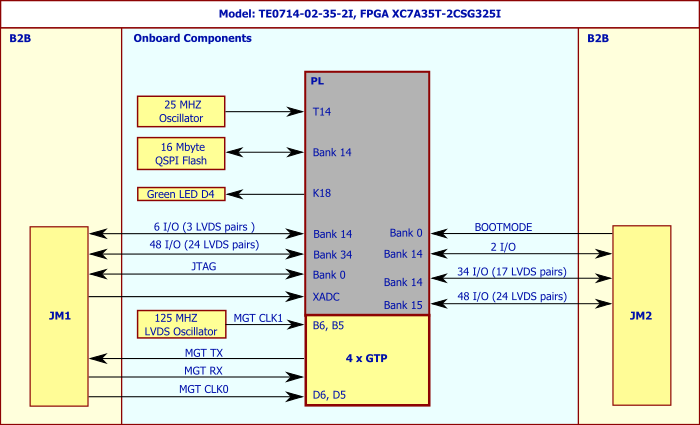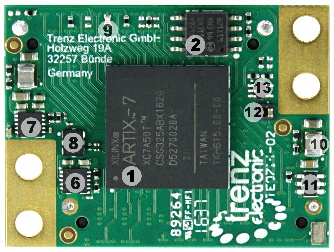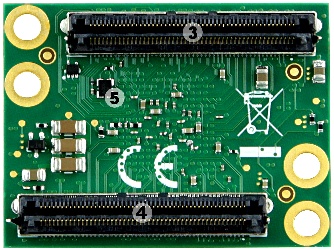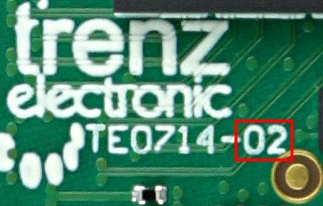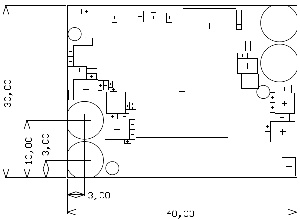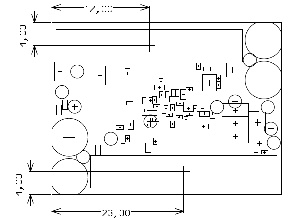Page History
...
The Trenz Electronic TE0714 is an industrial-grade SoM (System on Module) based on Xilinx Artix-7, 16 Mbyte Flash memory and powerful switching mode power supplies for all on-board voltages. A large number of configurable I/O's is provided via rugged high-speed stacking strips. All modules in 4 x 5 cm form factor are mechanically compatible.
Block Diagram
...
Main Components
Top view | Bottom view |
Main Components:
- Xilinx Artix-7 FPGA, U4
- SPI Flash, U7
- B2B Connector, JM2
- B2B Connector, JM1
- MEMS Oscillator (PL Clock), U8
- Single Output Low-Dropout Linear Regulator, U6 (1.2V_MGT)
- Single Output Low-Dropout Linear Regulator, U5 (1.0V_MGT)
- Low-Jitter Precision LVDS Oscillator (GT Clock), U2
- Red Indication LED,D4
- Step-Down DC-DC Converter, U1 (1.0V)
- PFET Load Switch With Configurable Slew Rate, Q1 (3.3V)
- Low Power Step-Down DC-DC Converter, U3 (1.8V)
- Voltage Detector for Circuit Initialization and Timing Supervision, U23
Key Features
Xilinx Artix-7 (A15T, A35T, A50T)
- Rugged for Sock and High Vibration
- 16 MByte QSPI Flash Memory
- Differential MEMS Oscillator for GT Clocking
- MEMS Oscillator for PL Clocks (Optional)
- Plug-On Module With 2 × 100-Pin High-Speed Hermaphroditic Strips
- 144 FPGA I/O's (Max 68 Differential)
- XADC Analog Input
- 4 GTP (High-Performance Transceiver) Lanes
- GT Reference Clock Input
- Optimized I/O and Power Pins for Good Signal Integrity
- On-board High-Efficiency DC-DC Converters
- Power Supply for All On-Board Components
- eFUSE Bit-Stream Encryption (AES)
- One User Configurable LED
Assembly options Different configurations for cost or and performance optimization available upon request. Possible Available options are:
- FPGA Type (A15T, A35T, A50T), temperature grade
- GT Clock Frequency (or none if not assembledimplemented)
- PL Clock Frequency and precision (or none if not assembledimplemented)
- Config and B14 Bank Voltage: 1.8V or 3.3V
- SPI Flash type (or none if not assembledimplemented)
- LED Color (or none if not assembledimplemented)
- PUDC Pin strapping (pull high or pull down)
- GT Power Enable pin strapping (default power enabled or disabled)
Current Assembly Variants
| Note |
|---|
On REV 01 JM2 Pin 54 was connected to GND. When R27 is not populated, REV 02 is backwards compatible to REV 01. When R27 is set, check your baseboard to not connect this pin to GND. For all new baseboards JM2.54 should be used as VCCIO output (it will then be 1.8V or 3.3V depending the voltage settings on the module. |
Signals, Interfaces and Pins
Initial Delivery State
Storage device name | Content | Notes |
|---|---|---|
SPI Flash OTP Area | Empty, not programmed | Except serial number programmed by flash vendor |
SPI Flash Quad Enable bit | Programmed | |
SPI Flash main array | demo design | |
EFUSE USER | Not programmed | |
EFUSE Security | Not programmed |
Signals, Interfaces and Pins
JTAG Interface
JTAG access to the Xilinx Artix-7 device is provided through connector JM1.
Signal Name | B2B Pin |
|---|---|
| TCK | JM1: 89 |
| TDI | JM1: 85 |
| TDO | JM1: 87 |
| TMS | JM1: 91 |
Clocking
Clock | Default Frequency | IC | FPGA | Notes |
|---|---|---|---|---|
| CLK125MHz | 25 MHz | U8 | T14 | Frequency depends on the module variant |
| MGT_CLK | 125MHz | U2 | B6/B5 | Frequency depends on the module variant |
Boot Modes
Boot mode is controlled by the MODE signal on the board to board (B2B) connector:
MODE signal State | Boot Mode |
|---|---|
high or open | Master SPI, x4 Mode |
low or ground | Slave SelectMAP |
| Note |
|---|
SPI D2 and D3 have no pull-ups on the module so with PUDC=High option, those pins are floating if there are no pull-ups on baseboard. As those pins have SPI RESET function when Quad mode is not enabled, it is mandatory to either add pull-ups on user baseboard or program the Quad Enable bit in Flash nonvolatile status register. |
JTAG Interface
...
. |
...
...
...
...
Clocking
...
Clock
...
Default Frequency
...
IC
...
FPGA
...
Notes
...
25 MHz
...
U8
...
T14
...
125MHz
...
U2
...
B6/B5
...
Frequency depends on Assembly variant
LED's
There is one LED on TE0714 module:
LED | Color | FPGA | Notes |
|---|---|---|---|
D4 | Red | K18 |
|
Power
...
and Power-On Sequence
To power-up a module, For startup, a power supply with minimum current capability of 1A is recommended.
Power
...
Suppy
TE0714 needs one single power supply with nominal of 3.3V.
Power Consumption
| Test Condition (25C 25 °C ambient) | Vin VIN Current mA | Notes |
|---|---|---|
| TE0714-35, TEBT0714, empty design, GT not enabled | 110mA |
Power consumption measurements. Actual power consumption depends on the FPGA design and ambient temperature.
Power-On Sequence
There is no specific or special power-on sequence, single power source is needed as VIN, rest of the sequence is automatic.
Bank Voltages
Bank | Voltage | Notes |
|---|---|---|
0 Config and B14 | 1.8V or 3.3V | Depends on assembly optionmodule variant |
15 | User | Supplied from basebaseboard via B2B connector, max 3.3V |
34 | User | Supplied from basebaseboard via B2B connector, max 3.3V |
Initial Delivery state
...
Storage device name
...
Content
...
Notes
...
SPI Flash OTP Area
...
Empty, not programmed
...
Except serial number programmed by flash vendor
...
SPI Flash Quad Enable bit
...
Programmed
...
SPI Flash main array
...
demo design
...
EFUSE USER
...
Not programmed
...
EFUSE Security
...
Not programmed
...
Variants Currently In Production
| Module Variant | FPGA Chip Model | GT/PL Clock [MHz] | PUDC | GT PWR Enable | B14/Config Voltage [V] | R27 (VCCIO_0 on JM2 Pin 54) | SPI Flash | LED D4 |
|---|---|---|---|---|---|---|---|---|
| TE0714-02-35-2I | A35T-2I | 125/25 | High | Enabled | 3.3 | JM2 Pin 54 = VCCIO_0 (3.3 V) | S25FL127S | Red |
| TE0714-02-35-2IC6 | A35T-2I | 125/25 | High | Enabled | 1.8 | JM2 Pin 54 = Open | N25Q128 | Red |
| TE0714-02-35-2IC7 | A35T-2I | 125/25 | Low | Enabled | 3.3 | JM2 Pin 54 = Open | S25FL127S | Red |
| TE0714-02-50-2I | A50T-2I | 125/25 | High | Enabled | 3.3 | JM2 Pin 54 = VCCIO_0 (3.3 V) | S25FL127S | Red |
| TE0714-02-50-2IC6 | A50T-2I | 125/25 | High | Enabled | 1.8 | JM2 Pin 54 = Open | N25Q128 | Red |
| Note |
|---|
On REV 01 JM2 Pin 54 was connected to GND. When R27 is not populated, REV 02 is backwards compatible to REV 01. When R27 is set, check your baseboard to not connect this pin to GND. For all new baseboards JM2.54 should be used as VCCIO output (it will then be 1.8V or 3.3V depending the voltage settings on the module. |
Hardware Revision History
...
Changes
...
01
...
Current Hardware Revision, no changes
...
Hardware revision number is printed on the PCB board next to the module model number separated by the dash.
Technical Specifications
Absolute Maximum Ratings
Parameter | Min | Max | Units | Notes | Reference document |
|---|---|---|---|---|---|
Vin supply voltage | -0.1 | 3.6 | V | ||
| I/O Bank supply voltage | -0.5 | 3.6 | V | Xilinx document DS181 | |
| I/O input voltage for FPGA I/O banks | -0.4 | VCCO_X+0.55 | V | Xilinx document DS181 | |
| GT Transceiver | -0.5 | 1.26 | V | Xilinx document DS181 | |
Voltage on |
module JTAG pins | -0.4 | VCCO_0+0.55 | V | VCCO_0 is 1.8V or 3.3V nominal | Xilinx document DS181 |
Storage |
temperature | -40 | +85 |
°C |
Recommended Operating Conditions
| Parameter | Min | Max | Units | Notes | Reference document |
|---|---|---|---|---|---|
| Vin supply voltage | 3.135 | 3.45 | V | ||
| IO Bank supply voltage for I/O banks | 1.14 | 3.465 | V | Xilinx document DS181 | |
| I/O input voltage for I/O banks | -0.20 |
| VCCO + 0.20 | V | Xilinx document DS181 | |
| Voltage on |
| module JTAG pins | 3.135 | 3.465 | V | For |
| a module variant with 3.3V CONFIG Bank |
| option | Xilinx document DS181 |
| Note |
|---|
| Please check Xilinx datasheet DS181 for complete list of absolute maximum and recommended operating ratings for the Artix-7 device (DS181). |
...
Physical Dimensions
Module size: 40 mm × 30 mm. Please download the assembly diagram for exact numbers.
Mating height with standard connectors: 8 mm
PCB thickness: 1.6 mm
Highest part on PCB: approximately 2.5 mm. Please download the step model for exact numbers.
All dimensions are shown in mm. Additional sketches, drawings and schematics can be found here.
| Top View, Mounting Holes | Bottom View, Samtec Connectors |
Operating Temperature Ranges
Commercial grade modules
All parts are at least commercial temperature range of 0°C 0 °C to +70°C70 °C. The module operating temperature range depends on customer design and cooling solution. Please contact us for options.
...
All parts are at least industrial temperature range of -40°C 40 °C to +85°C85 °C. The module operating temperature range depends on customer design and cooling solution. Please contact us for options.
Weight
| Variant | Weight in g | Note |
|---|---|---|
| 2IC6 | 8.3 | Plain Module |
Revision History
Hardware Revision History
| PCB Revision | Changes | PCN link | Documentation link |
|---|---|---|---|
01 | Current Hardware Revision, no changes | - | TE0714-01 TRM |
| 02 | VCCIO0 added to B2B | PCN-20160815 | - |
Hardware revision number is printed on the PCB board next to the module model number separated by the dash.
Document Change History
Date | Revision | Authors | Description |
|---|---|---|---|
| 2016-12-01 | Jan Kumann | Changes in the documant structure, few corrections. | |
| 2016-11-18 | V.14
| Antti Lukats, Thorsten Trenz | changes Changes for REV 02 |
2016-06-01 | V.9 | initial Initial version |
Disclaimer
| Include Page | ||||
|---|---|---|---|---|
|

